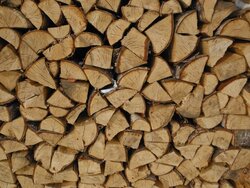So, it's a bit below freezing outside and will get to 15 F at night next week ... is my firewood still drying at 30F on a strlit night, or does that freeze lock the moisture inside the wood? Or, does the freezing cold wind still "dessicate" the wood no matter what? I think I know the answer, but I trust you experienced firewood-heads out there better than my intuition.
My guess is the colder it gets near or below freezing, the more that moisture simply crystallizes inside the wood, and does not dry ... except at the surface where it is dessicated or dried by the wind, and whatever moisture is thawed during warmer periods of time, and able to move toward the surface as a result of capillary action.
I'm guessing freezing winters don't do much for drying. The only thing that tells me I'm wrong is my dry skin and my lips — but then they are living warm and moist entities meeting cold and dry wind — not dead frozen entities with moisture frozen inside them.
OK ... I'm done theorizing ... have at it men and women of the woodshed, what's the deal?
My guess is the colder it gets near or below freezing, the more that moisture simply crystallizes inside the wood, and does not dry ... except at the surface where it is dessicated or dried by the wind, and whatever moisture is thawed during warmer periods of time, and able to move toward the surface as a result of capillary action.
I'm guessing freezing winters don't do much for drying. The only thing that tells me I'm wrong is my dry skin and my lips — but then they are living warm and moist entities meeting cold and dry wind — not dead frozen entities with moisture frozen inside them.
OK ... I'm done theorizing ... have at it men and women of the woodshed, what's the deal?




